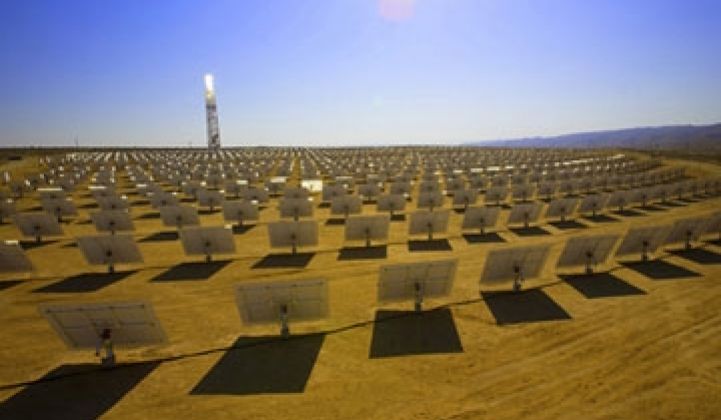The plunging costs of photovoltaic panels tend to dominate the solar news pages. It's a dramatic and disruptive development for customers and suppliers.
Industry lore has it that concentrated solar thermal (CSP) is going to have a difficult time competing against flat plate PV from First Solar and the Chinese suppliers like Suntech, Yingli, Trina, and Jinko.
Not true, according to the CEO of IPO-bound BrightSource Energy CEO, John Woolard.
Woolard said in a conversation with Greentech Media Research on Wednesday that BrightSource's CSP was substantially cheaper than PV and that BrightSource can "compete on cost alone." He added that BrightSource can beat PV on lower LCOE (levelized cost of energy), even with panel costs at $0.50 per watt.
One might ask, how is that possible?
Ivanpah, including a profit margin for BrightSource, is estimated to cost $2.2B for 392 megawatts (370 megawatts net); that is $5.95 per watt-AC. With a capacity factor of 30 percent, that would imply an LCOE of $0.146 per kilowatt-hour.
A large-scale PV plant, including profit margins for the suppliers, can be built for closer to $2.80 per watt-DC ($3.30 per watt-AC). With a capacity factor of 21 percent, that would imply an LCOE of $0.123 per kilowatt-hour.
For a complete analysis of the levelized cost of solar by technology, we have provided an excerpt from the GTM CSP Report.
So, how could BrightSource be cheaper?
The answer is that BrightSource is cheaper when comparing their next generation of plants (to be completed in 2014 and beyond) versus PV plants.
Looking at the chart displayed at the bottom of this article, BrightSource is saying that the projected improvements in the red line (power tower) between 2011-2014 will be realized.
BrightSource's next generation of plants will be much larger, thereby improving efficiency, lowering cost-per-watt, and lowering LCOE.
Woolard said that the company is "always pushing" to reduce cost and that higher efficiency lowers the cost of materials and labor.
The firm is raising the power of their modular field from 130 megawatts (like at Ivanpah) to 250 megawatts at future deployments. This helps the economics, as doubling the capacity only increases the power block costs by 40 percent.
Woolard contends that the higher capacity factor storage and the spinning aspect of the turbine improves power quality over that of "spiky DC power." Woolard adds that public utility commissions care about the "hidden costs behind these intermittent assets."
He put it plainly: "CSP has more value."
Brett Prior, a senior solar analyst at GTM Research, has looked at the LCOE economics of CSP in a recent report, Concentrating Solar Power 2011: Technology, Costs and Markets. (See chart below and the report for more details.) But even if solar can get its LCOE down to $0.10/kWh, that still seems high versus gas combined-cycle plants at $0.06 per kilowatt-hour. That is the harrowing number that solar and all new energy must compete with if it is going after dispatchable wholesale power. On the other hand, national and state renewable portfolio standards create a market for renewables. Natural gas, currently at unnaturally low price levels, will also likely rise in the coming years: escalating consumption could make the U.S. a net importer of methane by 2030.
Photovoltaic projects are winning PPAs at below the market price referent today in the neighborhood of $0.10 per kilowatt.
Another entrant in the CSP with molten salt storage field is Santa Monica, Calif.-based SolarReserve, which is building a 110-megawatt solar thermal plant in Nevada with help from a $737 million DOE loan guarantee. SolarReserve CEO Kevin Smith told us back at Intersolar that it could produce power for close to 12.5 cents per kilowatt-hour, a figure that will drop to 7.5 cents in a few years.




